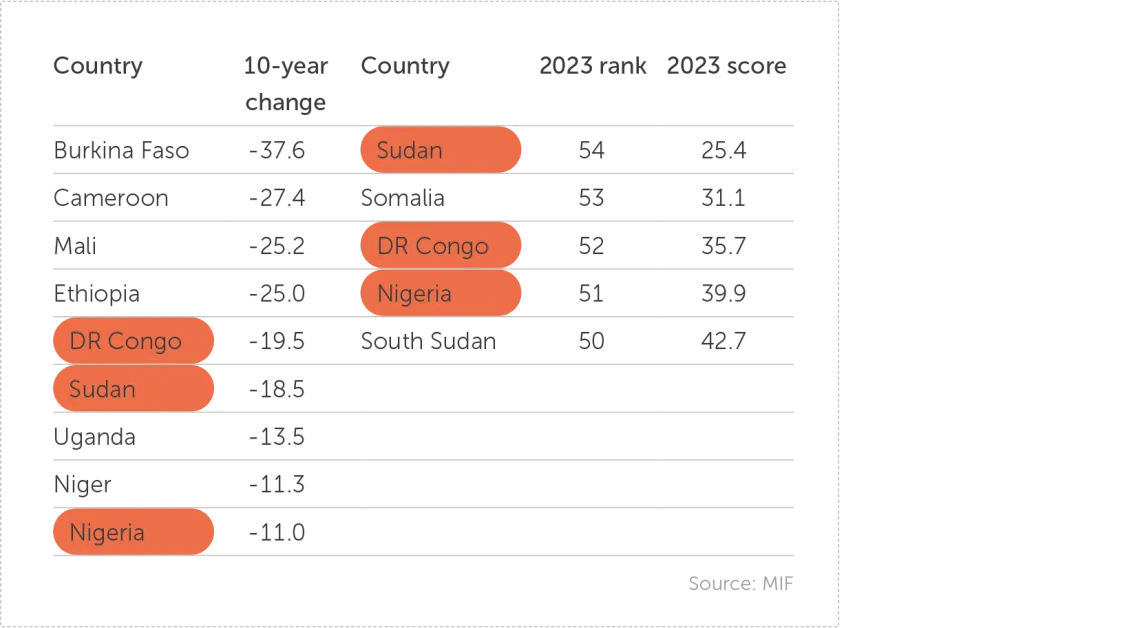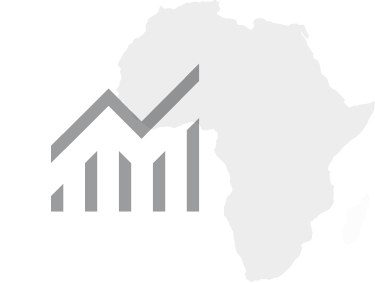Security & Safety in Africa: 2024 IIAG overview
13 February, 2025
Security & Safety is the most declined of all IIAG sub-categories
Dropping from an African average of 74.7 in 2014 to 69.7 in 2023, Security & Safety has deteriorated the most out of all 16 IIAG sub-categories (-5.0). All six underlying indicators register a decline over the past decade, led by Public Perception of Security & Safety and Absence of Violence against Civilians (-10.9 and -7.7, respectively).
Africa: Security & Safety, indicator scores (2014-2023)
Almost 80% of Africans live in a country where Security & Safety deteriorated since 2014
Over the last decade, the Security & Safety sub-category has consistently declined in 43 of 54 African countries, negatively affecting 77.9% of the continent’s total population. The most declined country is Burkina Faso (-37.6) while the most improved country is Libya (+25.7).
Comparing more recent developments with the first half of the decade shows that 26 countries, hosting over half of Africa’s population (53.9%), are experiencing increasing deterioration: Security & Safety is declining more rapidly since 2019 than in the five years prior. The second most dominant trend is slowing deterioration, meaning the negative trajectory has been decelerating since 2019. This is the case for eight countries, home to 16.8% of people.
Security & Safety: trends by % of total population (2014-2023)
Change is driven by public perception and violence against civilians
Deterioration is largely driven by changes in Public Perception of Security & Safety and Absence of Violence against Civilians. Ten countries register ten-year changes of over -20.0 in public perception, led by Eswatini (-52.2).
Nine countries register a drop of at least -20.0 in Absence of Violence against Civilians, spearheaded by Mali (-79.5), Cameroon (-75.4) and Burkina Faso (-73.2). Libya, the biggest improver in Security & Safety, has seen a remarkable improvement of +83.0 in Absence of Armed Conflict since 2014.
Despite the indicator’s influence on the negative trajectory of the subcategory, Absence of Violence against Civilians registers a wide range of scores between countries. In 2023, scores range from 0.0 (Mali and Sudan) to 100.0 (Seychelles). Thirteen countries pool at the top and reach scores of over 90.0, and 44 reach a score of over 50.0.
The ‘usual suspects’: protracted conflicts
Nine countries are experiencing double-digit deteriorations in Security & Safety since 2014, many of which have experienced recent military coups or outbreaks of civil war: Burkina Faso, Cameroon, Mali, Ethiopia, DR Congo, Sudan, Uganda, Niger and Nigeria.
All of the five lowest-scoring countries in 2023 (Sudan, Somalia, DR Congo, Nigeria and South Sudan) have ranked between 46th and 54th place in this sub-category in the last decade, meaning that their citizens are experiencing long-standing, protracted conflicts. Three of these ‘usual suspects’ are also among the most deteriorated countries: Sudan, DR Congo and Nigeria.

9 countries have seen double-digit declines, led by Burkina Faso, Cameroon and Mali
Northern Africa is the only region seeing improvements in Security & Safety
Averaged across their member states, all AU regions except Northern Africa are showing signs of deterioration, albeit with great variability in trends at country level. Northern Africa’s (Algeria, Egypt, Libya, Mauritania, Morocco and Tunisia) positive change of +6.2 since 2014 primarily rests on improvements in Libya (+25.7) and Egypt (+11.8). Morocco (+1.2), Mauritania (+0.9) and Algeria (+0.3) improve marginally while Tunisia is the only country to register a decline over the last ten years (-2.7).
Due to Libya’s ‘catching up’ with the best performing country Algeria, the range between top and bottom country in this region has narrowed from 42.7 in 2014 to 17.3 in 2023.
Regional (Western African) security zones are deteriorating at a faster rate
Security & Safety in the four recently withdrawn or suspended ex-ECOWAS members (Burkina Faso, Guinea, Mali and Niger) has deteriorated by -19.1 since 2014, five times more than in current ECOWAS members (-3.6). Similar observations can be made for other regional Western African security zones like the Multinational Joint Task Force, the Sahel G5 and, most recently, the so-called ‘Coup Belt’ stretching from Guinea to Sudan.
In the seven Coup Belt countries (Chad, Burkina Faso, Gabon, Guinea, Mali, Niger and Sudan), Security & Safety has deteriorated by -14.5 on average in the last decade.


